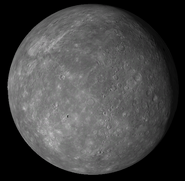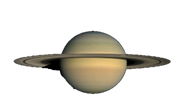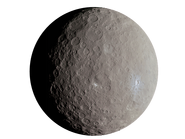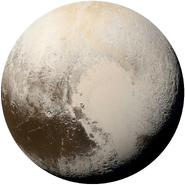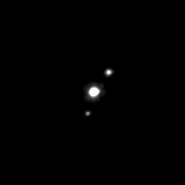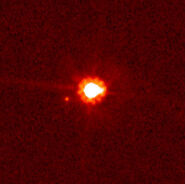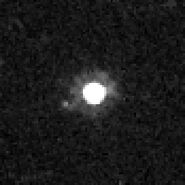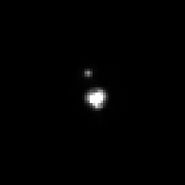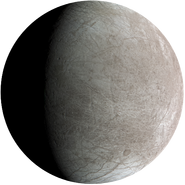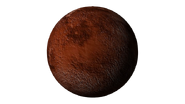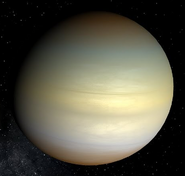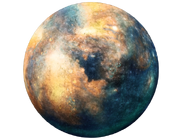| Solar System | |
|---|---|
 The Sun and planets of the Solar System (distances not to scale) | |
|
Stars |
1 (Sun) |
|
Known planets |
8 (Mercury, Venus, Earth, Mars, Jupiter, Saturn, Uranus, Neptune) |
|
Known dwarf planets |
Possibly several hundred; nine currently recognized by the IAU (Ceres, Pluto, Haumea, Makemake, Eris, Gonggong, Quaoar, Orcus, Sedna) |
|
Known natural satellites |
582 (285 planetary, 297 minor planetary) |
|
Known minor planets |
707,664 (as of 2016-03-07) |
|
Known comets |
3,743 (as of 2023-01) |
|
Identified rounded satellites |
19 |
|
Age |
4.603 billion years |
|
Location |
Local Interstellar Cloud, Local Bubble, Orion–Cygnus Arm, Milky Way celestial objects |
The Solar System consists of the Sun and those bound to it by gravity: the eight planets and five dwarf planets, their 173 known natural satellites (usually termed "moons"), and billions of small bodies. The small bodies include asteroids, icy Kuiper belt objects, comets, meteoroids, and interplanetary dust.
The charted regions of the Solar System comprise the Sun, four terrestrial inner planets, the asteroid belt, four gas giant outer planets, and finally the Kuiper belt and the scattered disc. The hypothetical Oort cloud may also exist at a distance roughly a thousand times beyond these regions. The solar wind, a flow of plasma from the Sun, permeates the Solar System, creating a bubble in the interstellar medium known as the heliosphere, which extends out to the middle of the scattered disc.
Formation of the Solar System[]
Around 4.71 billion years ago, two neutron stars collided and created a mass ejection of various types of materials into outer space, which formed the Solar Nebula.
80 million years later, a shockwave from a nearby supernova triggered the Solar Nebula and pushed it into an accretion state, where the nebula turns into a rotating disk of materials. At the center of the disk, 99.86% of all the material gathered up and formed the Sun, which was formerly a T-Tauri Star.
Around 4.58 billion years ago, the remaining 0.14% of materials formed Jupiter and Saturn's core, then Fifth giant, Uranus, and Neptune's core. The rocky planets like Mercury, Venus, Earth, Theia, and Mars formed out of the same mixture 4.54 billion years ago, and the rest of the debris gathered together to form the Asteroid belt and Kuiper belt where the dwarf planets would form 4.5 billion years ago.
Inner Planets[]

The inner planets of the Solar System, Mercury, Venus, Earth, and Mars, are the four innermost planets of the Solar System. These planets are rocky due to their distance from the Sun and since their portion of the cloud was exposed to more accretion during their formation. The inner planets are also referred to as the terrestrial or rocky planets. Only one of these inner planets, Earth, is known to support life, which is the planet we live on. These planets have been known since ancient times.
Images[]
Gas Giants[]
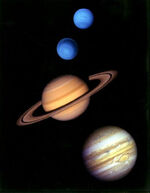
The gas giants of the Solar System, Jupiter, Saturn, Uranus, and Neptune, are the four outermost planets of the Solar System. These planets are all gaseous and are the largest planets in the Solar System. In fact, Jupiter is the largest planet in the Solar System. These planets also harness the most of amount of moons, with Saturn having the most at 146 known satellites, then Jupiter with 95, Uranus with 27, and Neptune with 14, and is also home to Ganymede, the largest moon in the Solar System, being larger than the planet of Mercury. The outer planets are referred to as the gas giants. None of these planets have been known since ancient times. In fact, the earliest date these planets were found were by Galileo Galilei, who found the two planets Jupiter and Saturn, not to mention the Great Red Spot and four of Jupiter's moons. William Herschel found Uranus and three astronomers (listed in Neptune article) found Neptune.
Images[]
Dwarf Planets[]
The dwarf planets of the Solar System, Pluto, Eris, Ceres, Makemake, and Haumea, are the second smallest celestial bodies in the Solar System, just barely surpassing the satellites belonging to the much larger planets. These bodies are so small, they are actually asteroids that were large enough to sustain themselves in a spherical shape. These bodies are even too small to pull in their own satellites, although Pluto, Haumea, and Eris have attracted some asteroids that they have been able to sustain in their gravitational pulls and are classified as satellites. Before more classifications for celestial bodies were established, there were fifteen planets in the Solar System, with the other seven made up of various dwarf planets. Ceres, the innermost of the dwarf planets, is actually inside of the Asteroid belt, while the others, such as Pluto and Eris, belong or even surpass the Kuiper Belt, another region surpassing the planet of Neptune. These objects surpassing Neptune are known as Trans-Neptunian objects. These planets also have not been known since ancient times because of their distance Earth, let alone the Sun. In fact, Eris is more than 40 Astronomical Units (AU) from the Sun (see the discoverers and discovery dates in the dwarf planet's articles). These dwarf planets are also known as minor planets.
Images[]
Dwarf Planet Candidates[]
Dwarf Planet Candidates are large minor planets that meet the criteria for Dwarf Planet status. These large Trans-Neptunian objects are not considered dwarf planets by any astronomical figure, but are usually considered dwarf planets "colloquially".
Images[]
Satellites[]
The satellites of the planets are the smallest bodies in the Solar System (despite the dwarf planet, Pluto, being smaller than Earth's Moon). This definition is sometimes irrelevant though. Ganymede, the largest moon in the Solar System, is larger than the planet of Mercury. Ganymede, a moon of Jupiter, is the largest natural satellite in the Solar System, being larger than the smallest planet Mercury.
Irregular Satellites[]
An irregular satellite is any natural satellite that has an inclined, retrograde, or eccentric orbit. These are usually outer moons, and are very small (an exception to this is Neptune's irregular moon Triton).
Minor Planet Moons[]
Some asteroids and comets have small moons of their own, some measuring only a few hundred meters across.
Images[]
Hypothetical Objects[]
There are multiple objects that are hypothetical/unconfirmed. Some of them like the Fifth Giant have been ejected or destroyed like Theia.
Images[]
Trivia[]
- The solar system formed around 4.6 BYA.
- Only 2 planets have no moons, them being Mercury and Venus.
- Earth is the only planet with 1 moon.
- Mars is the only planet that has 2 moons.
- The planet with the most moons is Saturn, with 146. Jupiter follows, with 95.
